|
|
Grass
|
Growing Conditions
|
Use
|
Mature Size
|
Color
|
Other Notes
|
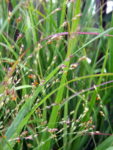 |
Switchgrass (Panicum virgatum)
|
Moist to dry soil and full sun, tough grass |
Seeds, winter shelter, butterfly host |
3-7 feet tall; 2-4 feet wide |
Reddish-purple fades to tan |
Mulch heavily to prevent seeds from spreading. Native; deer resistant |
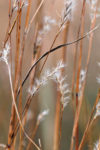 |
Little Bluestem ‘Nash’ (Schizachyrium scoparium)
|
Well-drained soil and full sun, moderate growth, adaptable |
Seeds, foliage provides cover, nesting |
2-3 feet tall; 1-2 feet wide |
Blue-green foliage turns dark red to purple to tan |
Good for naturalized areas and erosion control. Tall upright foliage and seed heads used for cut flowers. Needs space as it readily reseeds. Larval host for Skipper butterfly. Native. Bunching growth habit. |
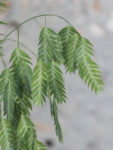 |
Inland Sea Oats (Chasmanthium latifolium)
|
Fast growing, erosion control, medium water, adaptable to any soil, prefers shade, native |
Seeds, good for pots |
2-4 feet tall; 2-4 feet wide |
Green then age to tan |
Attractive arching seed heads in late summer. Readily reseeds. Cut back in late summer for seed control. Stems used for dried flower arrangements. |
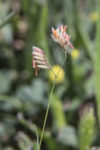 |
Blue Grama (Bouteloua gracilis)
|
Drought/heat tolerant; low-medium water, most soil types |
Seeds; larval plant; good for wildflower meadows |
6 to 12 inches tall; 6 to 12 inches wide |
White seed heads that grow horizontally; green or greyish leaves |
Eyelash-shape, horizontal seed heads. Native, short-grass prairie plant. Bunching growth habit. Can be used as lawn replacement. Larval host for Skipper butterflies. |
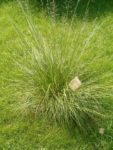 |
Prairie Dropseed (Sporobolus heterolepis)
|
Full sun, prefers well-drained soil but will tolerate rocky or clay soils |
Seeds; bird nesting material; structure for native bees |
2-4 feet tall; 2-4 feet wide |
Pink and brown tinted blooms |
Native. Fine-textured, bunching round clump growth habit. Use as edging plant or ground cover. Delicate seed heads. Dethatch yearly. |
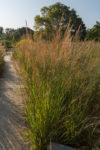 |
Indiangrass (Sorghastrum nutans)
|
Well-drained to moist soil; prefers full sun but will tolerate some shade |
Seeds; foliage provides cover; good for wildflower meadows |
4-6 feet tall; 2-3 feet wide |
Dark orange or purple in fall, yellow seed heads that age to brown |
Lush upright growth habit. Good for screens and erosion control. Corn-like structure. |
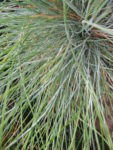 |
Blue Fescue (Festuca glauca)
|
Well-drained soil and full sun |
Seeds, nesting material, |
6-18 inches tall; 12-24 inches wide, neat mounds |
Blue-green foliage, golden spike heads |
Semi-evergreen and drought tolerant. |
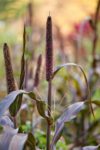 |
Purple Millet (Pennisetum galucum)
|
Tolerant of heat and low moisture; full sun |
Seeds |
4-6 feet tall with 8-12 inches flower plumes |
Gold to Purple foliage and seed heads |
Tender perennial but starts easily from seed. Corn-like foliage. Good in pots. Dense, bushy growth habit. Stems used for dried flower arrangements. |
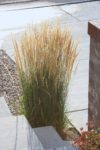 |
Karl Foerester Feather Reed Grass (Calamagrostis x acutiflora)
|
Sun-part shade, average soil, medium moisture, tolerates wet soil |
Seeds |
3-5 feet tall, 18-30 inch wide |
Blue-grey foliage; white showy seed heads |
Hybrid, non-native with strong, upright, narrow leaves. Use as an accent or border plant. Good for erosion control. Stems used for dried flower arrangements. |
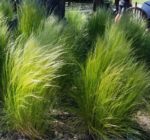 |
Mexican Feathergrass (Nassella tenuissma)
|
Alkaline soils |
Seeds, nesting material |
1-3 feet tall; 1-2 feet wide |
Green flowers in summer, evergreen |
Fine textured leaves forming dense clumps. Drought and frost tolerant. Graceful in the breeze. Reseeds readily and can be invasive. |
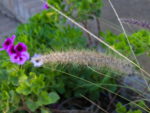 |
Dwarf Fountaingrass ‘Hameln’ or ‘Little Bunny’ (Pennisetum alopecuroides)
|
Full sun, well-drained; drought tolerant |
Seeds, nesting material |
3 feet tall; 2 feet wide |
White plumes turn russet in fall; fall foliage is golden-russet color |
Uniform soft textured, compact, clumping growth habit. Non-native. Use as an accent or container plant. Stems used for dried flower arrangements. Susceptible to cold damage if cut back too early in fall – wait for the foliage to die. |
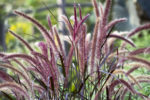 |
Purple Fountaingrass ‘Ruburn’ (Pennisetum setaceum)
|
Sunny location, well- drained soil |
Seeds, nesting material |
3-4 feet tall, 4 feet wide |
Purple or burgundy foliage, purplish seed heads |
Good for the garden or containers. Fast growing. Propagate by division since it rarely sets seed. |
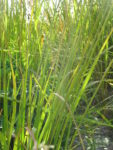 |
Tufted Hairgrass (Deschampsia cespitosa)
|
Moist, rich, organic soil and full-part shade |
Seeds, nesting material |
2-3 feet tall; 1-2 feet wide |
Dark green |
Clumping growth habit. The fine, hair-like grass creates a waterfall appearance.
Excellent ornamental for part-shade, petite, rock or woodland gardens. Goes well with ferns. Low-maintenance. |
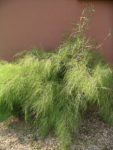 |
Bamboo muhly (Muhlenbergia Dumosa)
|
Fertile well-drained soil |
Cover, nesting material |
3-6 feet tall; 3-6 feet wide |
Straw-colored blooms late summer |
Fast growing. Cut back in late winter. Graceful and wispy leaves. Can be grown in large container. |
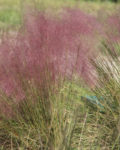 |
Gulf Muhly (Muhlenbergia capillaris)
|
Sun, medium moisture |
Cover, nesting material |
1-3 feet tall; 1-3 feet wide |
Fluffy pink blossoms late summer |
Soft-looking, slender green leaves. Clumping growth habit. Native. Cut back late winter. Spectacular when backlit by the sun. |
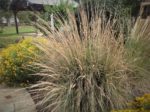 |
Lindheimer’s Muhly (Muhlenbergia lindheimeri)
|
Medium water use but drought tolerant. |
Seeds, cover, nesting material |
2-5 feet tall, 2-4 feet wide |
Silver seed heads in fall |
Semi-evergreen, finely textured leaves with a clumping growth habit. Moderate growth. Elegant swaying seed heads. Texas Superstar® plant. Native. Deer resistant. Popular variety is ‘Regal Mist’. |
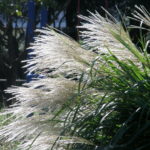 |
Japanese Maiden Grass (Miscanthus sinensis)
|
Well drained soil |
Seeds |
4-6 feet tall; 2-4 feet wide |
Blooms vary in varieties |
Slow to moderate growth. Blooms late summer. Deer and rabbit resistant. Stems used for dried flower arrangements. Good visual interest in winter. |
















